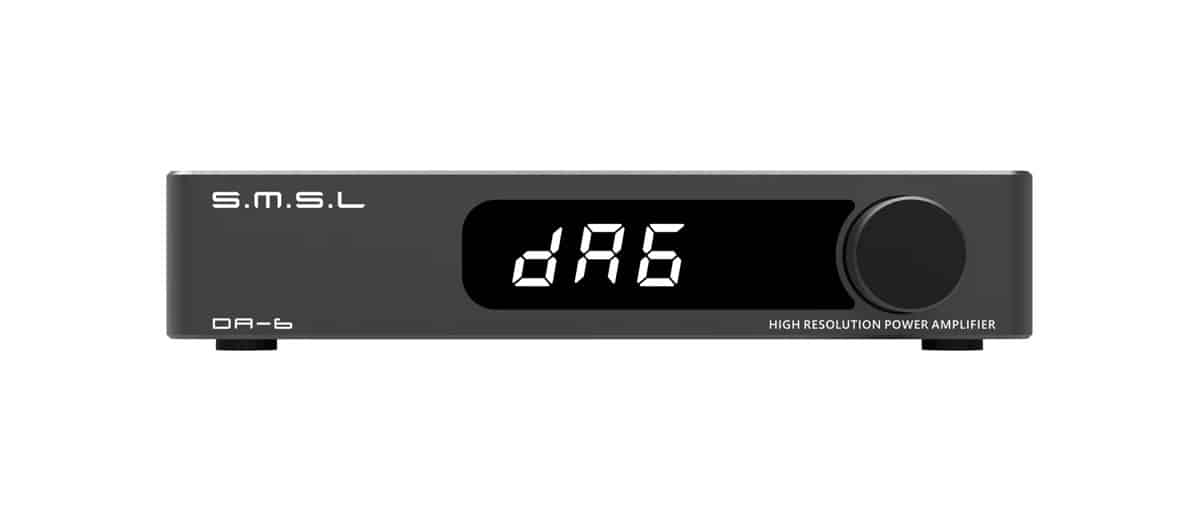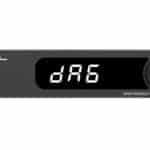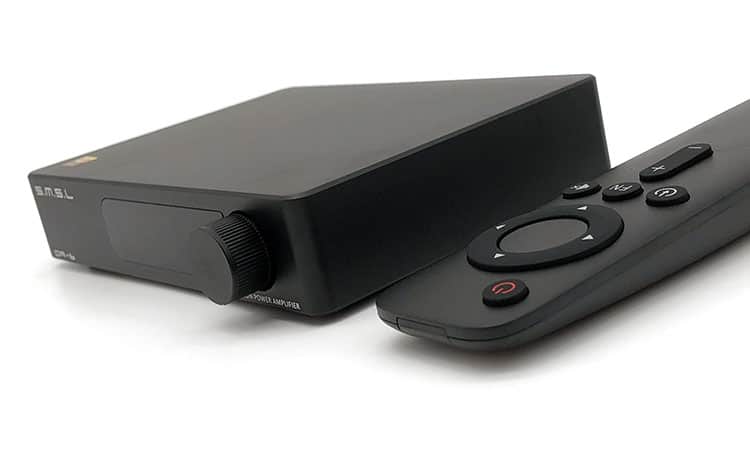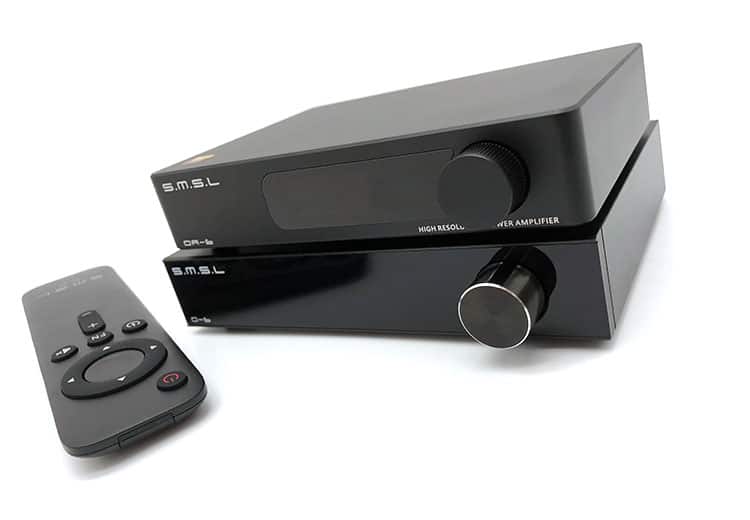Today’s feature is a review of the new SMSL DA-6 which is a budget-orientated desktop Class D power amplifier design for use with speakers. It is priced at $99.
Disclaimer: This sample was sent to us for our honest opinion. Headfonics is an independent website with no affiliate links or partnerships. We thank Shenzhen Audio and SMSL for giving us this opportunity.
Click here to learn more about SMSL products that we have previously featured on Headfonics.
Note, that this article follows our latest scoring guidelines which you can find in more detail here.
A few months ago, the AO200 landed here at Headfonics which is a Class-D power amplifier from SMSL offering an impressive for its size 90W per channel power output at just $279. SMSL may have seen an opportunity to go even smaller and cheaper; hence, we have their latest baby, the DA-6.
The DA-6 is not just any power amplifier, at least on paper, having a surprising list of baked-in tech that any growing enthusiast will find hard not to get curious about.
So, while the DA-6 is not balanced and loses a few perks from the more expensive AO200, having a simple companion for your desk listening might suit budget audiophiles a bit more.
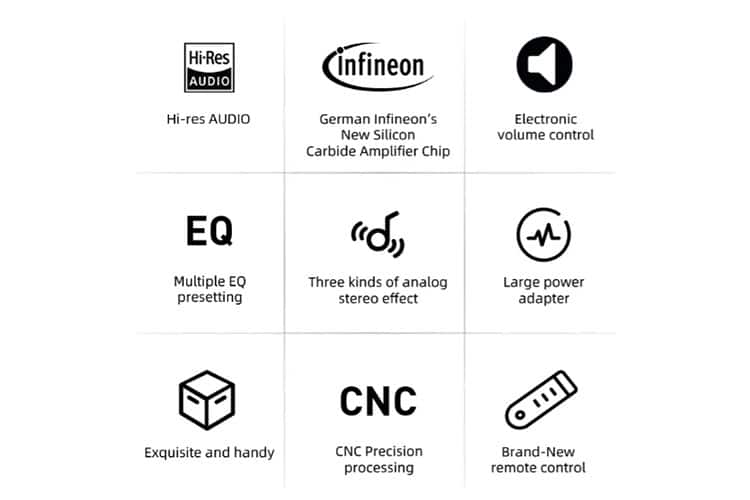
Tech Highlights
Built around an Infineon chip using Class-D topology, 4W speakers have a dynamic headroom of up to 70W/channel.
While I would have appreciated knowing the specific amp chip SMSL chose for the DA-6, we at least get some other specifics like the unit’s 0.004% low distortion levels and 20Hz-40kHz wide frequency range which is beyond decent for the price.
Using an electronic volume knob, the goal is to remove noise associated with resistor-based analog design. What is more, since this method digitally controls volume, it also addresses any channel imbalance that usually occurs with low-cost amplifiers and also makes it possible to integrate an external remote.
Thus far, I already think the $99 price tag is already spot-on for the DA-6 but SMSL is not yet done with adding user customizability to the sound.
Realistically speaking, this is a nice touch since pairing with speakers is made easier by the EQ presets, surround modes, and the ±14dB control for bass and treble.
Design
Because the DA-6 is in the budget segment, my immediate reaction upon first taking it out is to check on its build. The 350g box has reasonable heft and rigidity without any unexpected hollowness owing to SMSL’s use of thick aluminum alloy which they claim is also helping dissipate heat.
Setups that maintain a brighter theme will not miss out as a silver color trim is made available in addition to the black that SMSL usually offers. But still, even with the darker finish seen here, a very soft glow spreads lightly and follows around the chamfered edges for a lowkey but still notable profile.
The white charactered seven-segment display and the infrared receiver in the front of the DA-6 are safely situated behind an aesthetically cut glossy glass panel.
While it doesn’t fully cover the face of the unit, it spans around half the length beginning from the small volume wheel for a moderate twist in elements.
From behind, the ports are cleanly laid out in a linear arrangement and with enough room between one another. But since the binding post is not set in parallel, users should take extra care in checking the polarity.
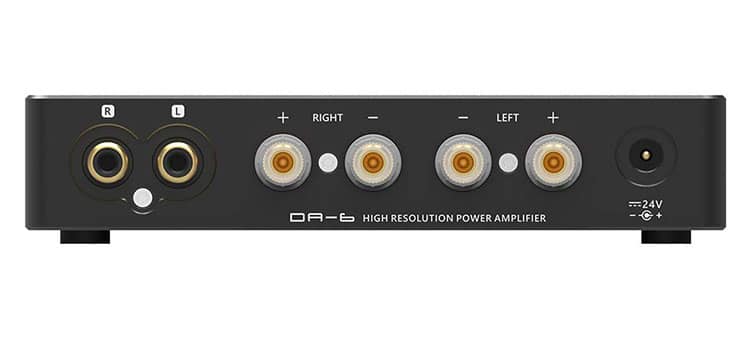
I/O
While the presence of a digital volume, EQ, and surround presets gives way to the impression of internal digital processing, there is no digital or Bluetooth input available in the DA-6.
Outwardly simple, the rear ports on the DA-6 are just as alike sporting a short but useful list of IO, gold plated to improve performance.
To push music to the DA-6, all you need is a single-ended DAC to pair with the RCA sockets. And the evenly laid out binding post can accept banana speaker plugs and even bare wire connections for making stereo speakers sing.
Controls
It takes a few seconds before the DA-6 initializes after plugging it into the wall. But unlike SMSL DACs such as the D-6 that cycle through a couple of displays, the startup sequence of the DA-6 is limited to ‘da6’ and its current volume setting.
The perpetual rotation of the volume wheel in each direction can increment the amplifier’s loudness between -60 and -00 volume levels. And to access the EQ, brightness, bass, treble, and other neat settings built into the amp, just short press the button until the desired description and then turn to adjust for preference.
Having experienced the multi-function knob of SMSL before, I found very little difference in handling the DA-6. The only key peculiarity from what I expected is when I tried to long press the volume wheel to put the device on standby but it instead restarts.
Thankfully, there is another way to control the DA-6 in the form of a remote. Having a power, mute, and display button, the remote can place the DA-6 to sleep and even turn the display off aside from the expected functions it shares with the volume knob.
Packaging & Accessories
Enclosed in the same type of carton, with the same design, and only differently sized from other SMSL products, the DA-6 is asking to be freed straightaway.
To be fair with SMSL, this approach helps reduce any extra cost in designing a new box each time while keeping their company image in check.
The DA-6 can be found safely stored towards the left part of the box right underneath some paper works. And right above the cutout for the amplifier, those expecting a straight cut unboxing will find a remote quietly waiting to be revealed.
As expected with a compact power amplifier that requires an external power supply, the huge 24V brick provided with the DA-6 is already taking up half the space of the box.
Being this big, it did catch SMSL’s attention to detail as the company marked it with its logo to tie up with the whole package.
Sound Impressions
Bass
Pushing towards accuracy with a bit of warmth, kick drums on the DA-6 sound relaxing rather than articulate. Sub-bass roll-off is gradual but does not add any effect in the room size department as the mid-bass tends to feel wide and slow.
A bit lacking in dispersion and nuance, the bass region of the DA-6 still catches up when crisper passages such as when bass guitar strings holding a note come on and it gains back some pace. Dynamics and detail retrieval in cleaner songs are more obvious.
Mids
What I’d say is a winner on SMSL’s implementation is in the midrange. When I put on vocal heavy or mid-centric melodies, the DA-6 rewards with a hefty amount of detail unfolding vibrato and second voices with enough clarity opening the potential of the speaker being paired.
Revealing pleasing amounts of echo and subtleties, vocals on the DA-6 are big with a touch of forwardness. Having no shout whatsoever, I find it a pleasing listen even though some may miss the energy on the upper ranges of their favorite singer.
Guitars focus on girth and accuracy in exchange for not having the shimmer and speed which lessens bite. Piano on the other hand is more realistic sounding but has a weaker presence than guitars.
Treble
Not faking detail with sharpness, the treble region is well represented if only a bit fuzzy at times giving leeway for bright pings and ringing to gain some control without sounding fatiguing. Violins have a gentle top-end roll that finishes off the pleasant weight of the note with an expansive diffusion.
The DA-6 is not the widest staging power amplifier out there. What it provides is honesty and well-defined instrument separation that barely blurs in key moments when the lack of definition pushes images together.
Tuning Control
Leaving the default settings on the DA-6 to have an idea where SMSL is going with their latest budget power amplifier, I was in for a refreshing surprise that it’s not as hard-hitting as their other gears.
Not the thrill machine I was expecting out of the box, it leaves room for tweaking the lows and highs which I’ll now get into.
Going into the settings section, my interest first went into changing the ±14dB range of bass and treble to maybe find a more suitable tuning for the Monitor Audio Silver 50 I was using.
Spoiler alert, while offering wide flexibility for gear pairing, I find the first 2 to 3 notches in either direction for both settings the only useful range unless I want to completely change the sound profile of my speakers.
Since I’m finding the sub-bass a bit recessed than I’d like, I upped the bass by one immediately bringing with it the life I was looking for but it does affect the midrange which I’m trying to avoid. Bringing it to the 2nd or 3rd increment will pump up the bass but the muddying of the vocal range is the biggest trade-off.
Adjusting the treble range to the 1st or 2nd setting speeds up the treble and introduces slight thinness in the upper midrange. It does however give horns a livelier character and vibrance which is quickly removed by lowering the treble below zero.
Those that will use the three stereo effects will hear an increasing amount of loudness, echo, and scale in each notch. While I find it a bit artificial sounding, I have to admit that I may simply be not the target consumer for this setting since some may use the DA-6 for home entertainment.
Synergy
Power
With the Monitor Audio Silver 50, a compact bookshelf speaker that has a nominal impedance of 8W and sensitivity level of 87dB hooked up to the DA-6, the 70W per channel headroom is more than enough to push it louder than needed.
I only needed to set the amplifier at -32 for comfortable desk listening, but the Silver 50 did ask for more settling at -20 for a far-field setup in an average-sized room.
Being a capable speaker amplifier, the only thing I noticed is the low-level hiss that can be heard on the tweeters when I placed my head right up against the speaker to check for noise.
Pairings
The DAC I used in most of my listening impressions is the Chord Qutest for a trustworthy insight on the performance of the DA-6 and to avoid misplacing blame with any issues on the bottleneck. As you’ve read in the sound impressions, this pairing carries a melodious accompaniment that is quite serene and honest.
Having owned the Silver 50 for almost a year now, I know how bright yet nicely voiced it can be. The DA-6 noticeably doesn’t make the full use of the treble dexterity available but it does maintain the vocal performance I came to like with the Silver 50.
With the SMSL D-6 running as a downstream source of the DA-6, a few key areas tightened up, especially around the bass region that bites more aggressively. The midrange increased in its shout, putting more emphasis on piano and guitars for a more attention-grabbing sparkle.
Timbre-wise the treble region sounded very different from the D-6. The harmonic and relaxed flow of the violin on the Qutest became leaner and rigid, breathing some precision in dynamic notes.
The D-6 pairing even with its more steely and thinner top-end, is still not as airy as the Qutest. It is also not as natural in placing images, but kicks and plucks do disperse enough for a pleasing listen.

